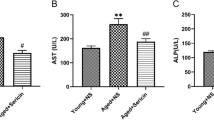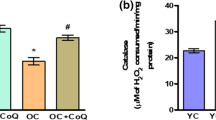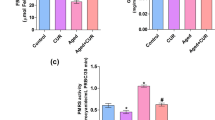Abstract
Protein carbonyls are formed as a consequence of the oxidative modification of proteins by reactive oxygen species and are commonly used as a marker of protein oxidation in cells and tissues. Melatonin has free radical scavenging ability besides its classical role as a hormonal signaling agent. Curcumin, a phytochemical, has a wide variety of biological actions including anti-inflammatory and antioxidative. In the present study, the effects of melatonin and curcumin on age-related carbonyl content of liver in mice were investigated. Young (1 month) and aged (18 month) were administered with melatonin (10 mg/kg body weight) and curcumin (90 mg/kg body weight) in dimethyl sulfoxide intraperitoneally. Livers were excised from each experimental group and processed. The level of protein carbonylation was assessed spectrophotometrically and further confirmed by Western blotting analysis. Protein carbonyls of liver have been found to be significantly higher in 18-month-old mice as compared to 1-month-old mice. The carbonyl content in 1- and 18-month-old mice decreases significantly upon administrations of melatonin and curcumin. This study thus suggests that the formation of protein carbonyls in the liver of the aging mice can be prevented by the antioxidative effects of melatonin and curcumin, which may provide health benefits in aging animals.



Similar content being viewed by others
References
Harman D (2000) Antioxidant supplements: effect on disease and aging in the United States population. J Am Aging Assoc 23:25–31
Kregel C, Zhang HJ (2007) An integrated view of oxidative stress in aging: basic mechanisms, functional effects, and pathological considerations. Am J Physiol Regul Integr Comp Physiol 292:R18–R36
Friguet B (2002) Protein repair and degradation during aging. Sci World J 2:248–254
Levine RL (2002) Carbonyl modified proteins in cellular regulation, aging, and disease. Free Radic Biol Med 32:790–796
Adams S, Green P, Claxton R, Simcox S, Williams MV, Walsh K, Leeuwenburgh C (2001) Reactive carbonyl formation by oxidative and non-oxidative pathways. Front Biosci 6:17–24
Fu SL, Dean RT (1997) Structural characterization of the products of hydroxyl-radical damage to leucine and their detection on proteins. Biochem J 324:41–48
Liu X, Theil EC (2005) Ferritin as an iron concentrator and chelator target. Ann N Y Acad Sci 1054:136–140
Cankurtaran M, Halil M, Yavuz BB, Dagli N, Oyan B, Ariogul S (2006) Prevalence and correlates of metabolic syndrome (MS) in older adults. Arch Gerontol Geriatr 42:35–45
Dubocovich ML, Cardinali DP, Delagrange P, Krause DN, Strosberg D, Sudgen D, Yocca FD (2000) Melatonin receptors. In: Girdlestone D (ed) The IUPHAR compendium of receptor characterization and classification, 2nd edn. IUPHAR Media, London, pp 270–277
Reiter RJ (2003) Melatonin: clinical relevance. Best Pract Res Clin Endocrinol Metab 17:273–285
Srimal RC, Dhawan BN (1973) Pharmacology of diferuloyl methane (curcumin), a non-steroidal antiinflammatory agent. J Pharm Pharmacol 25:447–452
Lao CD, Ruffin MTT, Normolle D, Heath DD, Murray SI, Bailey JM, Boggs ME, Crowell J, Rock CL, Brenner DE (2006) Dose escalation of a curcuminoid formulation. BMC Complement Altern Med 6:10
Aggarwal BB, Harikumar KB (2008) Potential therapeutic effects of curcumin, the antiinflammatory agent, against neurodegenerative, cardiovascular, pulmonary, metabolic, autoimmunre and neoplastic diseases. Int J Biochem Cell Biol 41(1):40–59
Rao CV (2007) Regulation of COX and LOX by curcumin. Adv Exp Med Biol 595:213–226
Goel A, Kunnumakkara AB, Aggarwal BB (2008) Curcumin as “Curecumin”: from kitchen to clinic. Biochem Pharmacol 75(4):907–913
Dkhar P, Sharma R (2011) Amelioration of age-dependent increase in protein carbonyls of cerebral hemispheres of mice by melatonin and ascorbic acid. Neurochem Int 59:996–1002
Dkhar P, Sharma R (2010) Effect of dimethyl sulphoxide and curcumin on protein carbonyls and reactive oxygen species of cerebral hemispheres of mice as a function of age. Int J Dev Neurosci 28:351–357
Levine RL, Williams JA, Stadtman ER, Shacter E (1994) Carbonyl assays for determination of oxidatively modified proteins. Meth Enzymol 233:346–357
Bradford MA (1976) A rapid and sensitive method for the quantitation of microgram quantities of protein using the principle of protein-dye binding. Anal Biochem 72:248–254
Zhang HJ, Xu L, Drake VJ, Xie L, Oberley LW, Kregel KC (2003) Heat-induced liver injury in old rats is associated with exaggerated oxidative stress and altered transcription factor activation. FASEB J 17(15):2293–2295
Helenius M, Kyrylenko S, Vehviläinen P, Salminen A (2001) Characterization of aging-associated up-regulation of constitutive nuclear factor-kappa B binding activity. Antioxid Redox Signal 3:147–156
Lavrovsky Y, Chatterjee B, Clark RA, Roy AK (2000) Role of redox-regulated transcription factors in inflammation, aging and age-related diseases. Exp Gerontol 35:521–532
Stadtman ER, Levine RL (2000) Protein oxidation. Ann N Y Acad Sci 899:191–208
Goto S, Takahashi R, Radak Z, Sharma R (2007) Beneficial biochemical outcomes of late-onset dietary restriction in rodents. Ann N Y Acad Sci 1100:431–441
Martin M, Macias M, Leon J, Escames G, Khaldy H, Acuna-Castroviejo D (2002) Melatonin increases the activity of the oxidative phosphorylation enzymes and the production of ATP in rat brain and liver mitochondria. Int J Biochem Cell Biol 34:348–357
Breusing N, Grune T (2008) Regulation of proteasome-mediated protein degradation during oxidative stress and aging. J Biol Chem 389:203–209
El Missiry MA, Fayed TA, El-Sawy MR, El Sayed AA (2007) Ameliorative effect of melatonin against gamma-irradiation-induced oxidative stress and tissue injury. Ecotoxicol Environ Saf 66:278–286
Li W, Lesuisse C, Xu Y, Troncoso JC, Price DL, Lee MK (2004) Stabilization of alpha synuclein protein with aging and familial Parkinson’s disease-linked A53T mutation. J Neurosci 24:7400–7409
Boukhtouche F, Vodjdani G, Jarvis CI, Bakouche J, Staels B, Mallet J, Mariani J, Lemaigre-Dubreuil Y, Brugg B (2006) Human retinoic acid receptor-related orphan receptor alpha1 overexpression protects neurones against oxidative stress-induced apoptosis. J Neurochem 96:1778–1789
Benot S, Goberna R, Reiter RJ, Garcia-Mauriño S, Osuna C, Guerrero JM (1999) Physiological levels of melatonin contribute to the antioxidant capacity of human serum. J Pineal Res 27:59–64
Yu ZW, Quinn P (1994) Dimethyl sulphoxide: a review of its application in cell biology. Biosci Rep 14:259–281
Kelly KA, Hill MR, Youkhana K, Wanker F, Gimble JM (1994) Dimethyl sulphoxide modulates NF-κB and cytokine activation in lipopolysaccharide-treated murine macrophages. Infect Immun 62:3122–3128
Reddy AC, Lokesh BR (1994) Studies on the inhibitory effects of curcumin and eugenol on the formation of reactive oxygen species and oxidation of ferrous ions. Mol Cell Biochem 137:1–8
Bala K, Tripathy BC, Sharma D (2006) Neuroprotective and anti-ageing effects of curcumin in aged rat brain regions. Biogerontology 7:81–89
Zhang DD (2006) Mechanistic studies of the nrf 2-keap1 signaling pathway. Drug Metab Rev 38:769–789
Balogen E, Hoque M, Gong P, Killeen E, Green CJG, Foresti R (2003) Curcumin activates the haem oxygenase-1 gene via regulation of Nrf 2 and the antioxidant responsive element. Biochem J 371:887–895
Ceriello A (2006) Controlling oxidative stress as a novel molecular approach to protecting the vascular wall in diabetes. Curr Opin Lipidol 17:510–518
Acknowledgments
Financial support to RS from UGC under Major Research Project (F. No. 34-288/2008(SR)) and the fellowship support from UGC-RGNFS (F.14-2(ST)/2007(SA-III) to PD are gratefully acknowledged. Authors thank the Department of Biochemistry, North-Eastern Hill University, Shillong for providing research facilities under UGC-UPE and DRS, and DST-FIST, New Delhi.
Author information
Authors and Affiliations
Corresponding author
Rights and permissions
About this article
Cite this article
Dkhar, P., Sharma, R. Attenuation of age-related increase of protein carbonylation in the liver of mice by melatonin and curcumin. Mol Cell Biochem 380, 153–160 (2013). https://doi.org/10.1007/s11010-013-1668-9
Received:
Accepted:
Published:
Issue Date:
DOI: https://doi.org/10.1007/s11010-013-1668-9




